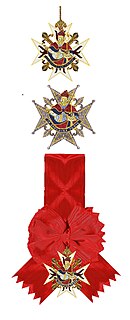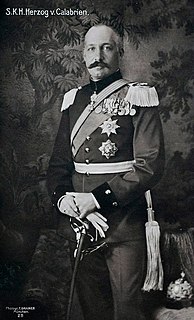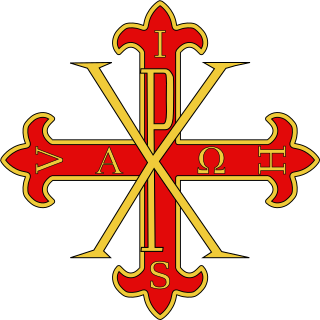
DomDuarte Pio, Duke of Braganza is a claimant to the defunct Portuguese throne, as the head of the House of Braganza. The Miguelist Braganzas, to whom Duarte Pio belongs as great-grandson of King Miguel I, is a cadet branch of the House of Braganza. With the extinction of male-line dynasts descended from Queen Maria II in 1932, King Miguel's descendants became the only male-line Braganzas remaining and the closest male-line heirs to the defunct Portuguese throne.

The Most Serene House of Braganza, also known as the Brigantine Dynasty, is a dynasty of emperors, kings, princes, and dukes of Portuguese origin which reigned in Europe and the Americas.

DonaIsabel, Duchess of Braganza, is a Portuguese businesswoman who married Duarte Pio, Duke of Braganza, the current pretender to the defunct Portuguese throne.
Infante, also anglicised as Infant or translated as Prince, is the title and rank given in the Iberian kingdoms of Spain and Portugal to the sons and daughters (infantas) of the king, regardless of age, sometimes with the exception of the heir apparent or heir presumptive to the throne, who usually bears a unique princely or ducal title. The wife of a male infante was accorded the title of infanta if the marriage was dynastically approved, although since 1987 this is no longer automatically the case in Spain. Husbands of born infantas did not obtain the title of infante through marriage, although they were occasionally elevated to the title de gracia at the sovereign's command.
A dynastic order, monarchical order, or house order, is an order under royal patronage, bestowed by the head of a currently or formerly sovereign royal family as legitimate fons honorum. These are often considered part of the cultural patrimony of the royal family. They are orders of chivalry, and orders of merit just as those distributed by sovereign states, but dynastic orders were often founded or maintained to reward service to a monarch, or the monarch's subsequent dynasty.

DomDuarte Nuno, Duke of Braganza was the claimant to the defunct Portuguese throne, as both the Miguelist successor of his father, Miguel, Duke of Braganza, and later as the head of the only Brigantine house, after the death of the last Legitimist Braganza, King Manuel II of Portugal. In 1952, when the Portuguese Laws of Banishment were repealed, the Duke moved his family to Portugal, thus returning the Miguelist Braganzas to their homeland and becoming the first of the former Portuguese royal dynasty to live in Portugal since the deposition of the monarchy, in 1910.

The Illustrious Royal Order of Saint Januarius is a Roman Catholic order of knighthood founded by Charles VII of Naples in 1738. It was the last great dynastic order to be constituted as a chivalric fraternity, with a limitation to Roman Catholics and a direct attachment to the dynasty rather than the state. The founder of the order, Charles VII of Naples, ruled from 1734 until 1759.

DomAfonso de Santa Maria, Prince of Beira is a Portuguese prince and eldest son of Duarte Pio, Duke of Braganza, Head of the Portuguese Royal Family. As heir to his father, Afonso is styled as Prince of Beira and Duke of Barcelos and is first in the line of succession to the former Portuguese throne.
DomHenrique, Duke of Coimbra was an Infante of Portugal (prince), as the youngest son of Duarte Nuno, Duke of Braganza, Head of the Portuguese Royal Family. His brother, Duarte Pio, Duke of Braganza, is the current head of the royal family.

Prince Ferdinand Pius, Duke of Calabria, was head of the House of Bourbon-Two Sicilies and pretender to the throne of the extinct Kingdom of the Two Sicilies from 1934 to 1960.

Prince Ranieri Maria Gaetano, Duke of Castro was a claimant to the headship of the House of Bourbon-Two Sicilies.
Prince Ferdinand of Bourbon-Two Sicilies, The Duke of Castro was a claimant to the headship of the former Royal House of the Two Sicilies.

The Sacred Military Constantinian Order of Saint George, also historically referred to as the Imperial Constantinian Order of Saint George and the Order of the Constantinian Angelic Knights of Saint George, is a dynastic order of knighthood of the House of Bourbon-Two Sicilies. Currently, the grand magistry of the order is disputed among the two claimants to the headship of the former reigning House of Bourbon-Two Sicilies as heirs of the House of Farnese, namely Prince Pedro and Prince Carlo. The order was confirmed as a religious-military order in a 1718 papal bull owing to a notable success in liberating Christians in the Peloponnese. Alongside the Sovereign Military Order of Malta it is the sole international Catholic Order which still has this status today. Although it is not an order of chivalry under patronage of the Holy See, membership is restricted to practising Catholics.

Prince Carlo of Bourbon-Two Sicilies, Duke of Castro is one of the two claimants to the headship of the former House of Bourbon-Two Sicilies.

The Order of the Immaculate Conception of Vila Viçosa is a dynastic order of knighthood of the House of Braganza, the former Portuguese Royal Family. The current Grand Master of the Order is Duarte Pio, Duke of Braganza, the Head of the House of Braganza.

Princess Anne of Bourbon-Two Sicilies, Dowager Duchess of Calabria is the widow of Infante Carlos, Duke of Calabria. She is the third daughter and fifth child of Henri, Count of Paris, Orléanist claimant to the defunct French throne, and his wife Princess Isabelle of Orléans-Braganza.
The Royal Equestrian and Military Order of Saint Michael of the Wing is a Portuguese Roman Catholic dynastic order that is believed to have been founded in 1147 in the Alcobaça Monastery in Alcobaça, Portugal, by King Afonso I of Portugal, in commemoration of the Conquest of Santarém from the Moors in 1147. The name was chosen in honour of the military Saint Archangel Michael, who assisted in the victory in the shape of a wing in the sky.

Pedro de Alcântara Carlos João Lourenço Miguel Rafael Gabriel Gonzaga de Orléans e Bragança, known as Pedro Carlos of Orléans-Braganza is a forest engineer, one of two claimants to the defunct Brazilian throne, and head of the Petrópolis branch of the Imperial House of Brazil.

Prince Pedro of Bourbon-Two Sicilies, Duke of Calabria, is the only son of Infante Carlos, Duke of Calabria (1938–2015) and his wife, Princess Anne of Orléans. He is a claimant to the headship of the House of Bourbon-Two Sicilies, which ruled the Kingdom of Two Sicilies before the unification of Italy.
Luiz Gastão Maria José Pio Miguel Gabriel Rafael Gonzaga de Orléans e Bragança e Wittelsbach is the head of the Vassouras branch of the House of Orléans-Braganza and a claimant to the defunct Brazilian throne. The Vassouras branch claims the throne in opposition to the Petrópolis branch of the Orléans-Braganzas, headed by Pedro Carlos of Orléans-Braganza. Though both Luiz and Pedro Carlos are great-great-grandchildren of Emperor Pedro II of Brazil, of the House of Braganza, they dispute leadership over the Brazilian Imperial Family due to a dynastic dispute concerning their fathers, who were cousins.















